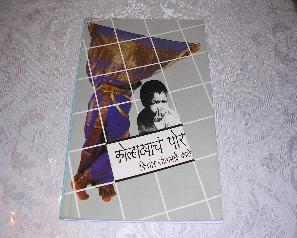Kolhatyache Por
Author: Dr. Kishor Shantabai Kale
Marathi translation:
Hindi translation:
Available in:
Pages: 116
Price: $2.44
Book Review: Dr. Avinash Patwardhan
Book Review
This book, a tragedy if you will, is a first person narrative that almost qualifies for being an autobiography, though it is not exactly a one. Recent premature accidental death of author has added an additional shade of melancholy to the whole story.
This work may not be a piece of classical art but its every line stirs heart and its every page wrenches soul. It portrays the grand pathos of a social order, just as Charles Dickens’ Oliver Twist does, even if it does not have the finesse of Dickens’ language and it unfolds in front of the reader the same genuine realistic pessimism that drama of O Neill’s plays do, although it may lack his flourish. On the other hand, in a very subtle and effective way, the author uses the stream-of-consciousness technique, though he might not be walking directly in the footsteps of Anthon Chekov’s eloquence. And while the story does not pomp the philosophical grandeur of Sartre, it does, time and gain ascend to the high note of existential angst. Of course the author can be best identified with Dostoevsky. The entire sketch, though a chaotic rambling and a chronicle of random events of a sort, is a pronouncement of existentialism.
Kolhati are a low caste in Hindu class-caste system in the state of Maharashtra in the mid-western region of India. Their womenfolk have been professional dancers for ages. These dancers, as the author describes, are bourn almost purposefully and bred deliberately by men of the caste who force their mothers, daughters and, sisters into dancing cum prostitution business, and then acting as their pimps live a comfortable, purposeless irresponsible life of consumption, tobacco and gambling. Pathetic and ironically as it may seem, these women, acquire the skills of dancing to make money; make it substantially through performances but also partly by subjecting themselves to prostitution with the rich audience that attend their shows; and then voluntarily give away almost all of their earning to the alpha male of the group, while they themselves along with their children suffer starvation, disease and indignity. Children are born, often out of wedlock to supply new dancers. If they happen to be boys, they grow to become general purpose handymen. Some among them create their own harem and herd eventually. Some women rebel and try to escape their fate by becoming mistresses of wealthy audience-clients, only to be thrown back on the tribe when they no more can serve as sex machines for their adapted masters. The end of their lives is also the climax of their misery because now they find themselves rejected by both, by their masters for having become useless, and by their tribe for having betrayed it.
This is a first person narrative of a boy who finds himself born to a Kolhati dancer. Summarily deserted by his mother, perpetually despised by his caretakers, ruthlessly exploited by his kin, ceaselessly eschewed by his peer, categorically denied dignity by his caste; pitifully begging for opportunity everywhere and through tortuous perilous routes he struggles his way from elementary school up to get into a prestigious medical school to eventually earn a M.D.
A story elucidating emotional paralysis, resignation to fate, epidemic inertia and universal lament, it is a pithy exposition of exploitation, inequity and social injustice. This small book indeed celebrates the triumph of protest, awakening of will and call to action, but somewhere deep within, this story is a cry for help- by the author, on behalf of many of his kin and kind who may or will never make it.
